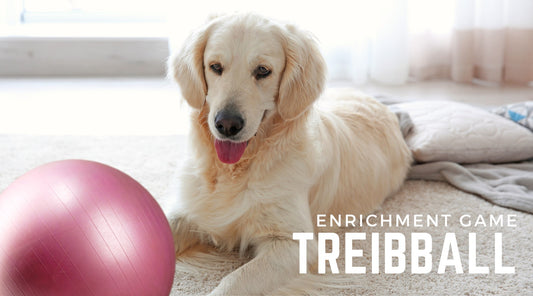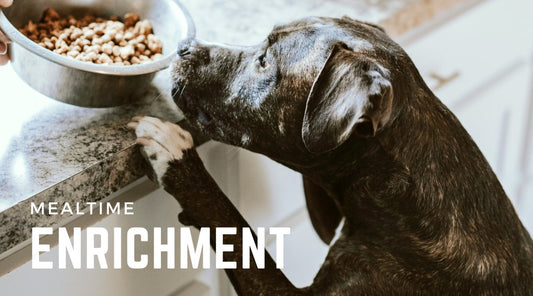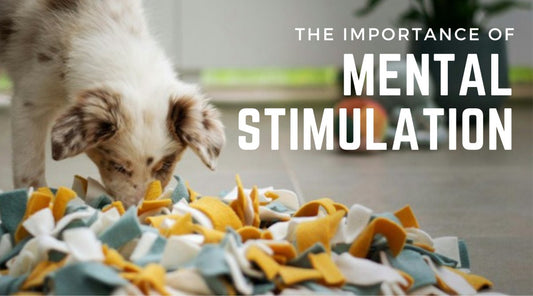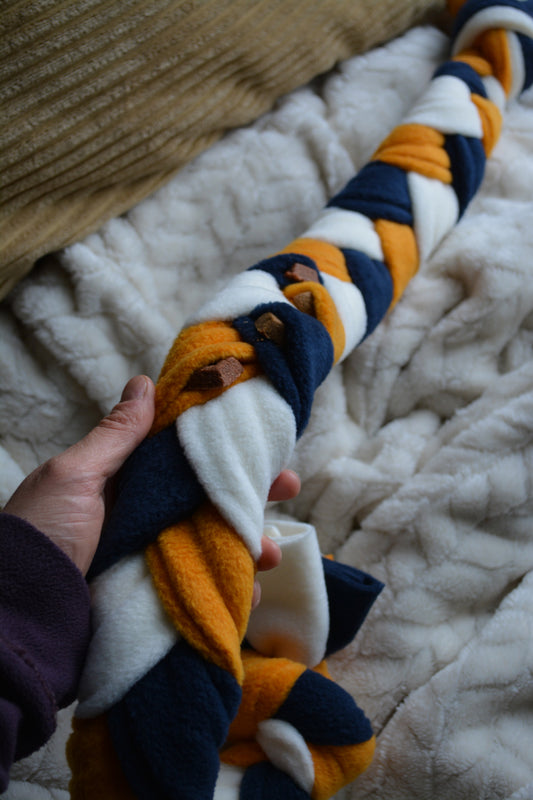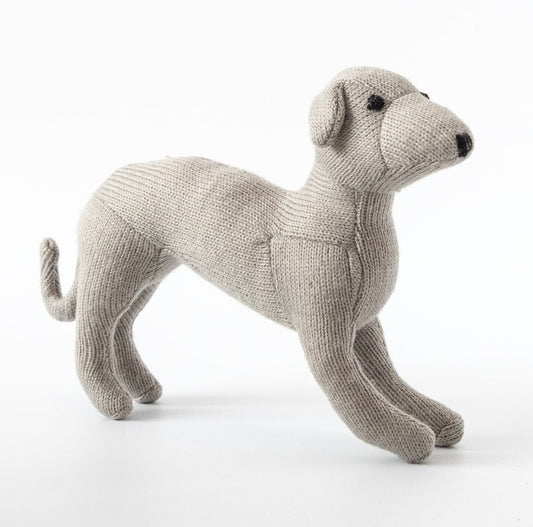So you’ve heard about scatter feeding dogs but you’re not quite sure what it’s all about? Let me get you caught up!
What is scatter feeding?
Scatter feeding dogs is simple and easy!
This slow-feeding enrichment activity involves scattering your dog’s dry food across a grassy area for them to forage. Think of a piglet with their snout to the ground, happily sniffing out truffles in the undergrowth!
Enrichment can be this simple. Or, increase the 'problem-solving' opportunity for dogs who need higher levels of mental stimulation.
In a moment, we’ll look at the different ways you can scatter feed and how to adjust this activity to suit your particular dog.
…But first, it’s important to understand why scatter feeding is such a foundational pillar for enrichment.

What are the benefits of scatter feeding dogs?
As with all enrichment, the purpose is to add something positive and mentally stimulating to your dog’s day that fulfils a natural behaviour. So how does scatter feeding dogs do this?
Benefit 1: Provides mental stimulation
Mental stimulation is crucial for calmness.
If a dog is chronically under-stimulated, they will be frustrated and prone to getting over-aroused. This compounds overtime which can lead to more serious behavioural issues.
The best and easiest form of mental stimulation is to get your dog sniffing more.
Much of what is taught to dogs is to make them fit better into our world. Sniffing is a dog’s dominant sense and the way they naturally explore. Therefore, enrichment is all about giving them time in their world and just letting them be dogs.
Sniffing is also extremely calming. When we exercise our dog’s brain through their nose, they become calmer, more settled and satisfied.
Mental stimulation enables them to sleep more which continues the calm cycle.
Benefit 2: Fulfils natural behaviours
Dogs are natural scavengers.
When your dog engages in their most fundamental behaviours of sniffing and eating, they get a dopamine release. This tells your dog what they’re doing is fun and rewarding and so they want to do more of that.
If you don’t mentally stimulate your dog, they’ll likely look elsewhere to get their dopamine kick. This may look like…
- Running off chasing scents and wildlife.
- Relentlessly playing with or pestering other dogs.
- Needing to play fetch over and over.
- Stealing and/or chewing your belongings.
Lack of enrichment and mental stimulation will also have a big impact on your training - think loose leash walking and recall.
Giving your dog plenty of enrichment and outlets for expressing natural behaviours is foundational to their mental wellbeing and they will be more relaxed for it. These include sniffing, foraging, chewing etc.
Meet your dogs needs first and any necessary training will become much easier.
Benefit 3: Boosts your dog’s confidence
The simplicity of scatter feeding is also beneficial – find the treat, eat the treat. This easy win helps boost your dog’s confidence and a confident dog is happy and less stressed.
Higher levels of confidence help dogs cope with everyday life and as well as supporting them in making ‘better’ decisions, such as recalling or not running up to every person or dog they meet.

Benefit 4: Calming & relaxing
As well as helping your dog’s mental well-being, calm sniffing also lowers the heart rate and slows everything down to a more relaxed level.
Like us, dogs benefit from activating their ‘rest and digest’ system instead of always being in ‘fight or flight’ mode.
Benefit 5: Introduces scent work at an easy level.
Scatter feeding dogs is a good starting point, especially if they are getting frustrated with more challenging puzzle toys.
This easy introduction to enrichment is easy for the owner and enjoyable and rewarding for the dog. It’s a win-win. Who knows, it may inspire you to try a scent class with your dog.
Benefit 6: Provides a method of slow feeding
This slow-feeding activity helps to prolong meals. This is good for dogs who otherwise gulp down their dinner and are most at risk of bloat (such as Great Danes, St. Bernards, Irish Wolfhounds, Boxers and other deep-chested, large breeds).
Scatter feeding is an easy way to utilise some of your dog’s daily food or treats for enrichment.

What you will need
- Dry food or treats!
- A safe area to scatter the food.
A grass lawn is best for scatter feeding. The purpose of the activity is calm sniffing so ensure the grass is long enough for your dog to have to use their nose to find the food (rather than just spotting each piece by sight).
Environmental Safety Considerations
- If you have a small back garden which your dog uses to go to the toilet every day, it would be better to scatter away from this on a different patch. Perhaps a front lawn? You can always put your dog on a long leash while scatter feeding.
- Ensure there are no chemicals and pesticides sprayed onto the grass.
- Be aware of poisonous plants and never scatter among these!
- Avoid scattering very early mornings when there may be slugs/slug trails on the ground.
- Rockeries and patios can also be used though check for poisonous creatures who may be hiding there!
- If you have a flat-faced dog, just make sure they are snuffling in an area which will not damage their eyes.
Always supervise your dog when scatter feeding. We wouldn’t want them to scavenge outside of a designated enrichment activity or to eat something they shouldn’t by accident.
As always, you should use your own judgement as applies to your particular situation.
Private field hire could be a good option if that is within your budget.

How to lower arousal levels by scatter feeding
Scatter feeding is a low-arousal activity for dogs who need more calmness in their life! We don’t need to physically exhaust our dogs to achieve a calm household.
My spaniel is much calmer from mental stimulation, enrichment and brain games than high-energy romps through the countryside!
My motto is: A calm dog is a happy dog (rather than a tired dog is a happy dog).
Don’t get me wrong, he still has time off-leash every day as sniffing and exploring interesting environments is the most enriching part of your dog’s day. I just use scatter feeding as a tool to help him adjust to new environments, reduce his arousal levels and create calmer walks.
If you have a high-energy dog, such as a working breed, mental stimulation through scatter feeding is likely going to be your new best friend.

Our scatter feeding journey
I scatter feed multiple times throughout the week. While Cam always gets excited about his scatter feed, and will wag his entire bottom enthusiastically (it’s part of his core personality), engaging his nose and brain for a sustained period helps to balance out his high drive, physical energy and arousal levels.
This is because sniffing is calming, whereas racing around like a lunatic spikes adrenaline levels.
…But don’t spaniels race around while sniffing?
Well, yes, they are breed to flush, search and retrieve and so running and sniffing is often all-in-one. If you have a spaniel from a long line of field trial champs, you will know how incredibly driven, single-minded and excitable they can be!
That said, there is much you can do and I have discovered he is not one-speed. He does indeed have a slower pace that I call the “mooch”. This is when he (still runs) but does so in a more leisurely, relaxed manner taking in calm sniffs. He’ll essentially, ‘smell the roses’.
This mooch is the holy grail.
He’ll get those stimulating sniffs but he won’t be racing around desperate for every sniff, leaping over logs and chasing pigeons…
Scatter feeding dogs creates opportunities for calm sniffing since it is all about slowing down.
For dogs who ‘lose their minds’ as soon as they get outside, it’s also a way to create some focus and structure. Organised fun, if you will.
The more you scatter feed, the more settled into the activity your dog can become.
Through scatter feeding, Cam’s movements became slower, calmer and more relaxed. So I piggybacked on this in the great outdoors.
Here’s what I did…
Please note that if you have a nervous dog, this may not be appropriate. Let them eat their food where they feel safe and focus on building their overall confidence levels.
I took scatter feeding to new environments because we were working on reducing excitement levels and I did this gradually. If a dog is over the threshold, they won’t be interested in food. So you can use that as a gauge and drop down a level or more.
Step 1: Scatter feeding the garden.
While the garden has more interesting scents than inside the house, familiarity can breed calmness since there’s no real novelty when a dog goes into their garden multiple times every single day. So the garden is a good place to start.
It’s also where your dog will likely feel most at ease, which is important, otherwise they won’t be interested in eating.
If you have a small lawn, you could break up their meal into portions. This way your dog will be working their nose more as there is less food to find over the space.
Once they have found all of the food, you can go ahead and scatter the next portion to extend the sniffing session.
Step 2: Scattering on the front lawn.
Once Cam was into a good rhythm of scatter feeding in the garden, I decided to try this at the front of the house.
Just stepping outside the front door was hugely stimulating for him, with all of the sights, sounds and smells rushing in (even within a very quiet area).
So I started by putting on his harness and leash (which can be an excitement trigger for some dogs) and going out to our front lawn to scatter feed.
This helps add an element of calmness to wearing a harness and leash, as opposed to these items always signifying a stimulating walk.
If you don’t have a front lawn, you could use a snuffle toy, the Puzzle Plait is a customer favourite.
Step 3: Scatter feeding in fields.
I then started scatter feeding in the field at the bottom of our garden.
This was perfect as it meant I could scatter across a much wider area and the grass was at least 10 times longer than our lawn which gave him a really good snuffle session (30 minutes+).
Usually, he would run around a field to no end, but after a scatter, he’d hop over the dry stone wall and back into the garden. This is partly because he’s ready for a drink after he’s eaten, but it’s still positive that he began choosing a sleep on the sofa over the allure of the countryside.
I always make sure we’re alone when scatter feeding as I don’t want him to be surprised by other dogs or have dogs eat food that may not agree with them (so always be mindful of this when scatter feeding outside).
It is important to note that bloat (a dangerous condition – see more on that below) can occur if a dog exercises on a full stomach.
At first, I used a long line to prevent him from running lengths of the field!
Step 4: Scatter feeding in the woods.
Bit by bit, we gradually expanded this to our local green spaces.
You will need to determine that the space is safe to scatter feed. In the summer, I do an adder check! You also want to avoid any plants that may be poisonous. It's also important putting down food that could be eaten by another dog, so be mindful where you scatter. I'm often out at 5am in summer so we don't see anyone else in my rural area.
Now, he is calm enough in our local woods to be able to scatter off-leash and continue for a calm walk.
Even if I don’t scatter feed in these areas, he’s so much calmer as a default. This has increased his sniffing and decreased his racing around. It’s been quite revolutionary.
When he’s in this ‘rest and digest’ mode, he’s not particularly interested in birds and he’s much more responsive – because his brain is calmer it can process what I am trying to communicate.
If a dog is over-aroused, they are more in a state of ‘fight or flight’.
Whether it’s through excitement or anxiety, they are over the threshold and therefore they have little interest or mental ability to do tricks or take treats from you. They’re just not in the right headspace.
This is why scatter feeding can help redress the balance because you’re feeding into calmness and confidence. He still gets super excited about new places and big hikes and I still do need to manage his arousal levels.
Sometimes he’ll get accosted by another dog while on his walk or he will find a football in the brambles and his adrenaline levels will surge.
If that happens to you, don’t feel like the walk is a failure and a write-off. These things happen and are often out of our control.
What you can do though is help your dog recover emotionally. Again, this is where scatter feeding comes in.
Once he is home and has physically settled down (1.5 hours post-walk is my general rule), I scatter feed on the lawn to help him get those much-needed calm sniffs. Then let him sleep undisturbed!

FAQ
Who can benefit from scatter feeding?
Enriching your dog’s life needn’t be overly complicated or time-consuming. As you’ve just seen, scatter feeding is so easy to do. It’s the perfect activity for those days when your head feels overly full or your energy is limited.
As I sometimes get chronic pain flare-ups, scatter feeding (“Hunter Gatherer” card in the enrichment deck) is my go-to activity when I need to give my spaniel a sustained sniffing session without walking miles.
Does your dog typically spend much of their walk racing around? Perhaps wanting to play fetch or chase with other dogs? If so, they may be over-aroused and in need of some calmness in their day.
Scatter feeding can help encourage your dog to slow down and sniff more.
Time spent sniffing interesting smells in the countryside is what a dog walk is all about for your dog.
Sniffing is beneficial for all dogs, helping them to relax and feel calmer, while also being the most mentally stimulating activity they can do!
After all, smell is a dog’s most prominent sense and so sniffing is how dogs explore the world.
If you have a super-sniffer breed, such as a spaniel or bloodhound, activities that involve nosework are a double bonus as they provide breed-specific enrichment.
What food is best for scatter feeding?
Scatter feeding is best done with dry food. If you raw feed and want to do scatter feeding, take a look at cold-pressed as an option.
You can also scatter feed with small chunks of fresh food such as cucumber, sweet potato etc.
Dry treats may be used in a scatter, though I’d recommend flinging these across a wider area so your dog has to work more for those higher-calorie treats. Since they are treats, your dog’s motivation will be higher so you can use less treats than you would their regular dry food.
Deep belly sniffing is quite the workout for your dog, so could offset additional food.
However, you will need to figure out what’s best for your dog. My spaniel is very active so bonus food and treats aren’t an issue, however, I do typically scatter with a portion of his daily dinner.

Where is best to scatter feed?
A grassy patch is the best area to scatter feed.
Ideally, grass should at least be a couple of inches long to ensure that your dog is seeking out the food using their nose rather than their eyes. This is important!
You can scatter feed on a short lawn as a slow-feeding activity, but it won’t provide the same amount of mental stimulation and have the same calming effect as a true sniffing session.
My spaniel typically spends at least 20 minutes foraging his food – I would aim for this as the minimum. So you will need to experiment with the size of the area you scatter across.
The bigger the area, the longer it will take your dog to find the food.
If you have an active, high-energy dog, and they are finished in 5-10 minutes, try widening your scatter radius.
Should you scatter feed on walks?
It’s important to be aware of bloat. This is a dangerous condition for dogs that can be fatal.
Some breeds are more prone to bloat than others, typically large or deep-chested breeds such as Great Danes, St. Bernards, Weimaraners etc.
Scatter feeding can help reduce the risk of bloat as it is a slow feeding approach, though high-intensity activity surrounding a meal may increase it.
As a general rule of thumb, my dog is fed at least 1.5 hours before he goes out for exercise or waits at least 1.5 hours after exertion. If Cam has really exerted himself or if I had a breed prone to bloat, this would be at least 2 hours.
This helps his body calm and cool down before eating a meal.
If you want to scatter feed in the countryside, ways to reduce the risk of bloat include:
- Going to an area where your dog is calm. (Cam is now very calm in our local woods as we regularly scatter feed there.)
- Going at a time when it’s cool, so your dog is not panting from the heat while eating.
- Having your dog on a long line can reduce the intensity and distance they run.
- Going somewhere specifically to scatter feed and then come home. You can do a ‘walk’ separately at a later time.
- Picking a quiet spot where you’re unlikely to be disturbed by other dogs as this may cause your dog stress while eating (it’s also not good for other dogs to be eating your dog food in case they have allergies so do choose your spot mindfully).
- Using a portion of their meal to scatter instead of the whole meal.
- Increasing the size of your scatter area to slow down eating.
How often should we scatter feed?
Foraging is a natural behaviour for dogs so it’s not necessarily something they will get ‘bored’ of – my spaniel has a very happy tail when he’s scatter feeding. He loves it. Never has he turned his nose up!
…But all dogs are different and some may be less interested or motivated to scatter feed and that’s ok.
The enrichment deck has 52 different activities so there may be something your dog prefers to do more often, so go based on what makes them happy!

If your dog seems uninterested in scatter feeding at first, persevere and see if you can encourage them. You can drop in some treats here and there to help increase motivation levels and get them started.
Or, they may be too anxious to scatter in the great outdoors and so you can use a snuffle toy or scatter in your garden where they feel safe.
While it can be beneficial to provide lots of scatter feeding opportunities for your dog throughout each week, variety is also a key component of enrichment. That’s why I created the enrichment deck, so I’m not doing the same couple of activities over and over.
So I personally don’t scatter feed every single meal, but I know some people do and swear by it!
If my dog has been on a long hike with me and is hungry, he has his food in a bowl.
Otherwise, I mix in other games and activities with his food.
Are there any disadvantages of scatter feeding?
Every dog is different and so there are always considerations. It’s important to note that scatter feeding may not be suited to certain dogs.
You may have heard of the term “Ditch the bowl” – intended as a positive movement to encourage dog owners to create more enrichment from their dog’s daily food allocation.
However, a predictable feeding routine is important for some dogs. We need to consider every dog as an individual and adapt to suit them.
What dogs may not be suited to scatter feeding?
- Shy, nervous and anxious dogs may feel better about consuming their food in a predictable and unchallenging routine (a bowl).
- Dogs in a new home or environment take time to settle in and adjust. If they are uncertain about their surroundings they may feel uncomfortable snuffling for their food.
- Those with unknown, challenging or rescue backgrounds (please discuss scatter feeding and other brain games with your rescue centre or behaviourist).
- Dogs who are prone to eating anything and everything likely don’t need further scavenging reinforcement through scatter feeding. It’s an issue that would be best addressed first with a behaviourist.
This is not to say scatter feeding can’t be a positive and calming enrichment activity for these dogs. Just a few notes to consider! It may come down to timing. It’s best to introduce any new enrichment activities when your dog is feeling happy, confident and secure. This helps to create a positive experience.
We’ll take a look at some ways you can adjust scatter feeding below.
Can I adjust scatter feeding?
Yes, always look at your circumstances and adjust to suit you and your dog. I’ve listed a few ideas below, though this is not exhaustive. If you have any questions, feel free to leave a comment.
Can I scatter feed if my dog is raw fed?
Scatter feeding is best done with dry food. You could look into cold-pressed food, which is more minimally processed and retains nutrients better than kibble. I use a handful of this here and there during the week to scatter feed.
Many different types of natural, grain-free treats are available.
Training treats are particularly good for scatter feeding as their small size goes further. You could also break up pieces of air dried treats to use.
Enrichment can also come in the form of food variety. Add in different food items for extra enrichment. This could include small chunks of other dog-safe food such as cucumber, cooked sweet potato, pieces of boiled egg, scraps of meat etc.
I use a combination of all of these and factor it into my dog's overall food intake.

What if my dog is nervous outside?
It's best to scatter feed in an area where your dog feels safe. A snuffle toy would be a good indoor option.
My dog is prone to eating things they shouldn't…
It may be best to avoid scatter feeding, or at least discuss this with a qualified behaviourist first.
Possibilities could include creating a boundary by including a “go snuffle” cue along with a designated snuffle toy.
If your dog is a chewer, scatter feeding on the grass would be the best option.
However, if you need to use a toy to scatter feed; a large, heavy-bottomed (rubber) snuffle mat may be best. While a large dog can pick up a snuffle mat, it’s much harder to do so than a smaller and lighter snuffleball.
Always supervise with snuffle toys and safely remove if they try to chew them.
If they are always trying to chew something, look into providing more appropriate edible chews such as raw bones.
Once they have a healthy outlet for chewing, you may find they become far less interested in chewing your items!
Can I scatter feed with multiple dogs?
Many dogs will happily scatter feed together, but it’s not always the case! It would be best to conduct enrichment activities separately if you think there could be conflict.

My dog is stressed, anxious or in a new home.
Consider timing; is now the right moment for enrichment or do they need more time to settle in and feel safe in their surroundings?
If you think scatter feeding or other brain games and enrichment activities would be beneficial, you could do it with a treat allocation. This way, it’s an optional activity with extra rewarding treats rather than them having to engage to fulfil hunger.
Ensure they can receive their main food within a predictable routine and without being challenged.
My dog chases light and shadows, would this help?
It would be best to consult a vet or qualified force-free behaviourist for this. They can help you put a plan in place as you may be dealing with Obsessive Compulsive Disorder.
Scatter feeding may well be an activity they recommend since it can be a good way to engage the nose.
Light or shadow chasing can be the result of highly active brains, anxiety, frustration or lack of physical and mental stimulation.
If it is down to boredom or having a super busy mind, increasing mental stimulation through brain games and relieving frustration through easy enrichment such as chewing can help dogs overcome this.
Again though, seeking qualified help will be the quickest route to identifying the cause and helping to resolve it.
I want to try scatter feeding but dog won't accept food outside.
If your dog seems confident, just uninterested, you could try using food that is more appealing to them or pointing it out.
Not all dogs are super sniffers though, so it may not be their top choice activity so think about what your dog finds enriching.
Dogs who get overstimulated outdoors are sometimes understimulated in general. (I.e. They feel bored at home and their walk is the only highlight of their day.) This creates a great deal of excitement around the outdoors. So more frequent outings could help them, along with brain games and enrichment.
Sometimes we’ll do a sniffy loose leash walk to a grassy area, scatter feed and walk home. This serves as a short but fulfilling outing.
Please note that you should find a quiet area away from other dogs to prevent any conflict.
These scatter sessions promote sniffing and are calming, so help to reduce arousal levels. For some dogs, the environment may always be more interesting than food, and that's ok.
Sniffing itself is stimulating and rewarding, so you don't always need to incorporate food.
However, you could try light scatter feeding as a calming activity when out on walks. I use a handful of training treats as bloat can be an issue if you feed too much during exercise.
You can always do scatter feeding at home to add extra sniffing to their time at home.
If your dog never accepts food outdoors and seems tense, you will likely need to work with them to help them feel more secure in new environments and bring down arousal levels.
As with any chronic behaviour issues, please seek professional guidance. If you are dealing with an anxiety issue, scatter feeding outdoors may not be helpful.

What does it mean if my dog isn't very sniffy or foodie?
Some breeds, such as sight hounds, may be less sniffy than those bred to have their nose on the ground. It’s ok if your dog is not particularly interested in scatter feeding.
Try to find out what games they enjoy or are motivated by.
Sometimes, a dog will need a little more help or encouragement to take part in an activity. You can start by scattering on short grass in a smaller area encouraging them to “find it” and praising them enthusiastically when they do.
You can also drop the odd ‘jackpot’ treat to add motivation.
If a dog is overstimulated or anxious, they likely won’t accept food. So start in an area they feel comfortable, such as the home. You could use:
- Snuffle toy
- DIY snuffle boxes (cardboard boxes with scrunched-up packing paper or old towels)
- Hard floors (kitchen etc)
Scatter feed in areas they feel comfortable. You can use various snuffle toys or make your snuffle boxes using cardboard boxes, scrunched-up packing paper and old towels.
If your behaviourist thinks scatter feeding outdoors is appropriate, they may suggest looking into private field hire. This can be a good way to ensure your dog will not be disturbed.

How to increase mental stimulation
Scatter feeding is a simple, easy activity and that is the beauty of it. However, dogs with very active brains may enjoy more challenging activities.
It’s important to note that challenges should always be fun and fulfilling not frustrating.
We should also ensure they can access food regularly without challenge.
Brain Game Level 1
Leave a patch of lawn for the grass to grow longer. This will increase the snuffle level since the dog will have to use their nose more.
Brain Game Level 2
You can increase the size of the area you scatter over and even incorporate different heights and terrain.
For example, scattering treats along accessible features such as sleeper boarders to rockeries etc. Just don’t scatter among gravel or small stones as dogs may accidentally eat this.
Brain Game Level 3
Create a DIY snuffle box! This will work on your dog’s confidence levels. Grab a cardboard box and fill it with scrunched-up packing paper and/or old towels and clothes. Scatter food among the layers for your dog to snuffle out!
Ensure the paper balls and fabric are large enough not to be a choking hazard!
For flat-faced dogs, it’s best to use super soft fleece snuffle mats or balls rather than anything that could be scratchy against their eyes.

Other pets
Do you have other pets? Scatter feeding can be great for them too – think natural grazers such as chickens and rabbits/other small herbivores. It is more natural for these animals to have the space to roam forage their food than to receive it in one sitting.
Scatter feeding is a simple enrichment for many pets.
Snuffle Games with a Puzzle Plait
In this video, I share additional ways I engage my dog in foraging and predatory outlets using the Puzzle Plait.


